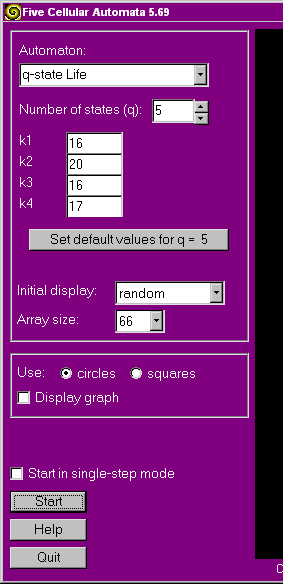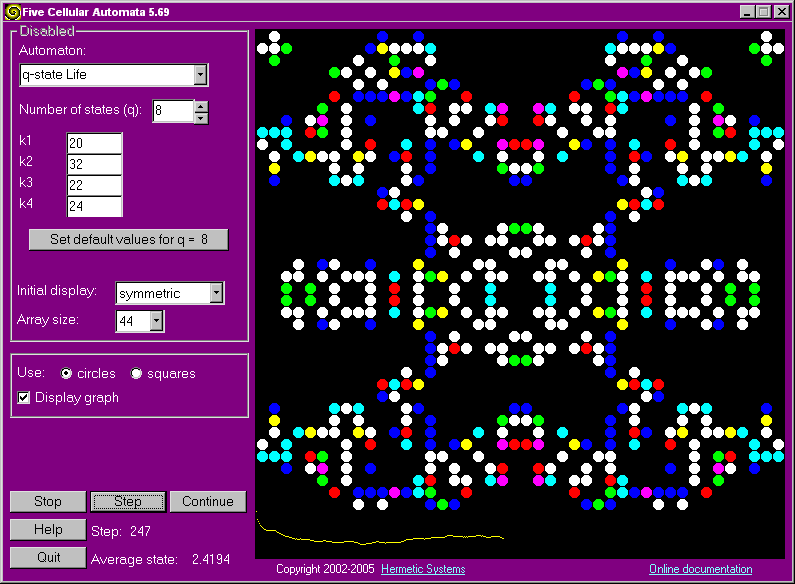 In Conway's Life cells are in one of two states, dead or alive. In q-state Life cells may be in any of q states, 1, 2, ..., q. The rules for the automaton are given on the Algorithms page.
In Conway's Life cells are in one of two states, dead or alive. In q-state Life cells may be in any of q states, 1, 2, ..., q. The rules for the automaton are given on the Algorithms page.The initial screen for q-state Life has controls as shown at right:
The values of q, k1, k2, k3 and k4 can be changed at will (subject to certain limits). Not all combinations of values produce interesting results. With some values the cells all die out after 10 or 20 steps. With others the cells proliferate and a disorderly mob results. To get good results the ranges k1 to k2 and k3 to k4 must be set so that the likelihood of a cell increasing its state at each step is just slightly less than the likelihood of its decreasing its state. After changing q, clicking on the Set default values button will set k1 etc. to values which experiment has shown to be of interest.
The size of the square array of cells can be set to any of 33, 44, 66, 88, 132, 176, 264 and 528.
Each state is assigned a unique color. State 1 is always black and state q is always white. Colors are assigned to the other states depending on the value of q:
| State: | 2 | 3 | 4 | 5 | 6 | 7 |
| q = 3 | magenta | |||||
| q = 4 | cyan | magenta | ||||
| q = 5 | cyan | magenta | yellow | |||
| q = 6 | cyan | green | red | yellow | ||
| q = 7 | cyan | green | magenta | red | yellow | |
| q = 8 | blue | cyan | green | magenta | red | yellow |
The initial state of q-state Life (as with the Belousov-Zhabotinsky reaction simulation) can be set to any of:
 |
 |
 | ||
|
Random, in which each cell begins in a randomly selected state (1 through q). |
Symmetric, in which there is a quasi-random assignment of states to cells but such that the overall display has vertical and horizontal symmetry. |
Diagonal, in which all cells lying on a particular diagonal have the same state. |
When the Display graph box is checked a graph is displayed which plots the average cell state against number of steps (time). A screen shot of 8-state Life, with graph, starting from a symmetric initial state is shown below. Note that k2 = 32 and k4 = 24 instead of the default 29 and 23, since slightly higher k2 and k4 values give better results when beginning from a symmetric, rather than a random, initial state.

| As in Conway's Life, one occasionally finds "gliders". Here is one from 6-state Life using the non-default values k1 = 14, k2 = 17, k3 = 14 and k4 = 15 (click on Reload or Refresh if the image is not moving, or enable GIF animation in your browser). | 
| Gliders can also be found in 6-state Life with the default k-values. |
| Next: The Belousov-Zhabotinsky Reaction | |
| Five Cellular Automata | |
| Hermetic Systems Home Page | |